
Shooting sports is a group of competitive and recreational sporting activities involving proficiency tests of accuracy, precision and speed in shooting — the art of using ranged weapons, mainly small arms and bows/crossbows.
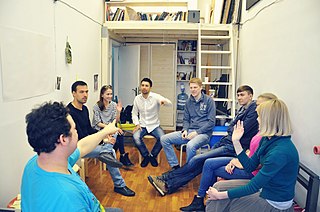
Party games are games that are played at social gatherings to facilitate interaction and provide entertainment and recreation. Categories include (explicit) icebreaker, parlour (indoor), picnic (outdoor), and large group games. Other types include pairing off (partnered) games, and parlour races. Different games will generate different atmospheres so the party game may merely be intended as an icebreakers, or the sole purpose for or structure of the party. As such, party games aim to include players of various skill levels and player-elimination is rare. Party games are intended to be played socially, and are designed to be easy for new players to learn.

Paintball is a competitive team shooting sport in which players eliminate opponents from play by hitting them with spherical dye-filled gelatin capsules called paintballs that break upon impact. Paintballs are usually shot using low-energy air weapons called paintball markers that are powered by compressed air or carbon dioxide and were originally designed for remotely marking trees and cattle.
Tippmann is an American manufacturer of paintball markers and paintball equipment, including military simulation (MilSim) kits. A related company, Tippmann Industrial Products manufactures manual and pneumatic heavy-duty sewing machines primarily used for leather, other leather-related equipment, and some industrial products. Originally a family-owned business run from Fort Wayne, Indiana, in 2004 Dennis Tippmann Sr. sold a majority ownership stake to Summit Partners, a private equity firm. Tippmann designed one of the first automatic markers, the use of refillable air systems in place of 12 gram cartridges, the "Cyclone Feed" system, the "Flatline" barrel, and the Tippmann C-3, the first propane-powered marker.

Capture the flag (CTF) is a traditional outdoor sport where two or more teams each have a flag and the objective is to capture the other team's flag, located at the team's "base", and bring it safely back to their own base. Enemy players can be "tagged" by players in their home territory and, depending on the rules, they may be out of the game, become members of the opposite team, sent back to their own territory, or frozen in place until freed by a member of their own team.

Tag is a playground game involving one or more players chasing other players in an attempt to "tag" and mark them out of play, usually by touching with a hand. There are many variations; most forms have no teams, scores, or equipment. Usually, when a person is tagged, the tagger says, "Tag, you're 'It'!" The last one tagged during tag is "It" for the next round. The game is known by other names in various parts of the world, including "running and catching" in India and "catch and cook" in the Middle East.

Scenario paintball is a colloquialism used to represent a diverse array of paintball events that encompass many themes that may include historical re-enactments, movies, current pop culture, futuristic or video game simulations, and more. Others have no theme at all. They frequently feature game mechanics such as "medics" and "snipers" and "helicopters" carried out through various simulations. The common denominator for this type of play is anywhere from 75 to 5000 players, with at least 6 hours of continuous play. These events average 12 hours of game play across a weekend in 2 major play periods. The longest and most challenging events run 24 hours straight with no breaks, with elite players covering ultra marathon distances. Instead of playing on a single field at a venue, all fields are combined into one continuous playable area. To further enhance the theme of a game, field locations may be named for important story locations, and props of various sorts are added to the game. These may be objects that players collect for points, or even vehicles that take part in the fighting, like paintball tanks. Players may don costumes specific to the theme, such as historic military uniforms or other costumes.
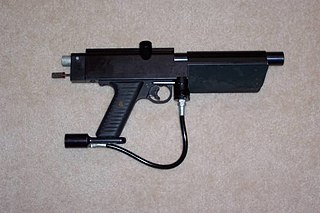
The Autococker is a closed-bolt semiautomatic paintball marker manufactured by Worr Game Products (WGP). It was one of the first paintball markers to be designed specifically for the sport, and has long been known throughout the paintball community for its popularity and customizability as well as its complexity. It is commonly believed that the closed-bolt design of the marker makes it inherently more accurate than its open-bolt counterparts, though this is disputed.
Smart Parts was a paintball manufacturing company in Latrobe, Pennsylvania, which filed for liquidation on July 28, 2010. As of August 22, 2010 Smart Parts' assets and intellectual property were acquired by Kee Action Sports.

A paintball marker, also known as a paintball gun, paint gun, or simply marker, is an air gun used in the shooting sport of paintball, and the main piece of paintball equipment. Paintball markers use compressed gas, such as carbon dioxide (CO2) or compressed air (HPA), to propel dye-filled gel capsules called paintballs through the barrel and quickly strike a target. The term "marker" is derived from its original use as a tool for forestry personnel to mark trees and ranchers to mark wandering cattle.
Paintball is an equipment-intensive sport and in order to safely conduct a game, every player requires a marker with propellant to fire the paint, a mask to protect the eyes and face, paintballs, and a loader to hold them. To ensure safety off the playing field, a barrel sock or plug for the marker is also compulsory.
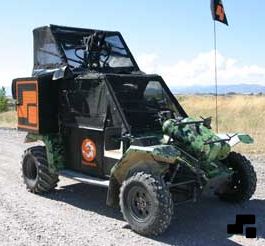
A paintball tank, also known as a paintball armoured vehicle, (pav), is a vehicle, or a portable structure that resembles a vehicle, sometimes used in the sport of paintball, usually with the intent of military simulation. The purpose of the tank is to provide a mobile shelter for one or several players, from which they may employ their markers against players on the opposing team. Small pneumatic guns, effectively low-powered potato cannons loaded with foam darts, are also often employed against other tanks.
Paintball is played with a potentially limitless variety of rules and variations, all of which are specified before the game begins. The most basic of all game rules is that players must attempt to accomplish a goal without being tagged with paintballs. Generally paintball is divided into either its original incarnation woodsball, or the small arena-based and tournament de facto speedball. Amongst these paintball game types, variations of basic rules can be played.
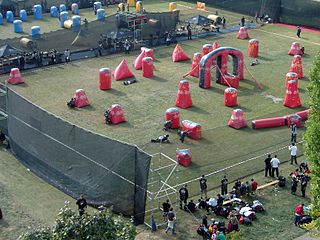
Speedball is one of the three distinct game variants in the sport of paintball, along with woodsball and scenario paintball.

The Ion is an electropneumatic paintball marker manufactured by Smart Parts. At the time of its release, the Ion was the first fully electropneumatic marker aimed at entry-level players, at a price point similar to Spyders and other mechanical blowbacks. The Ion has generally been credited with making high-rate-of-fire electropneumatic markers generally available, at a time when electropneumatic markers were considered out of reach of most casual or budget players.

Paintball pistols are a type of paintball marker used in paintball, which loosely resemble pistols. There are two main types of pistols: pump and semi-automatic.
WDP PAINTBALL LTD owns and operates NPF Bassetts Pole Adventure Park, a paintball site / adventure park in Birmingham., England. The company WDP is also known for manufacturing the Angel line of electropneumatic paintball markers.
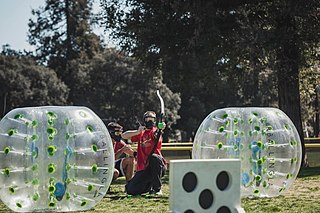
Combat archery, sometimes known as battle archery, is a sport similar to dodgeball, paintball or Nerf war played with bows and arrows tipped with foam.
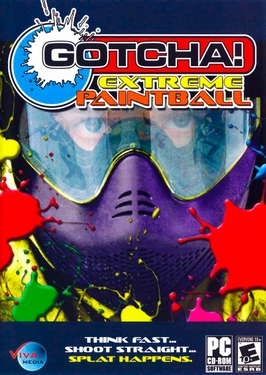
Gotcha! Extreme Paintball is a first person paintball video game developed by Sixteen Tons Entertainment and published by Gathering. The game was produced by Ralph Stock. It was released on Microsoft Windows and Xbox in Germany first in 2004, and the rest of Europe in 2004 and 2005, following a release in North America in 2006, published by Viva Media.
















